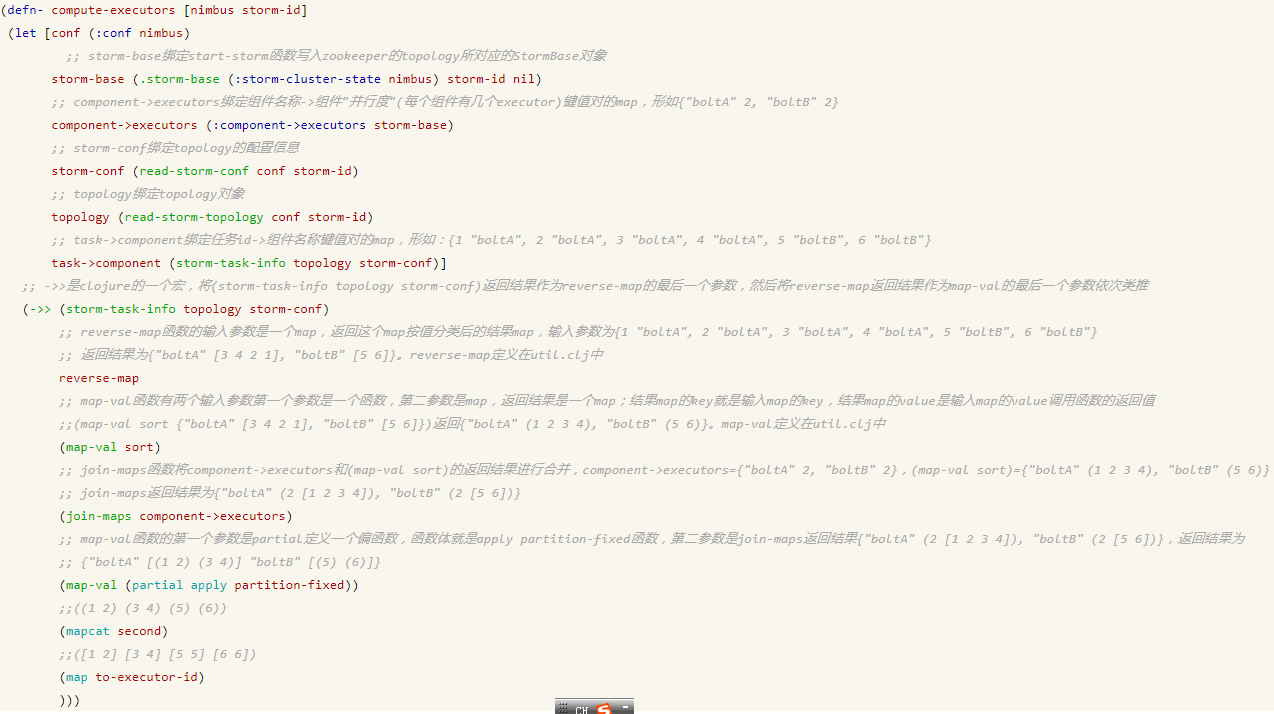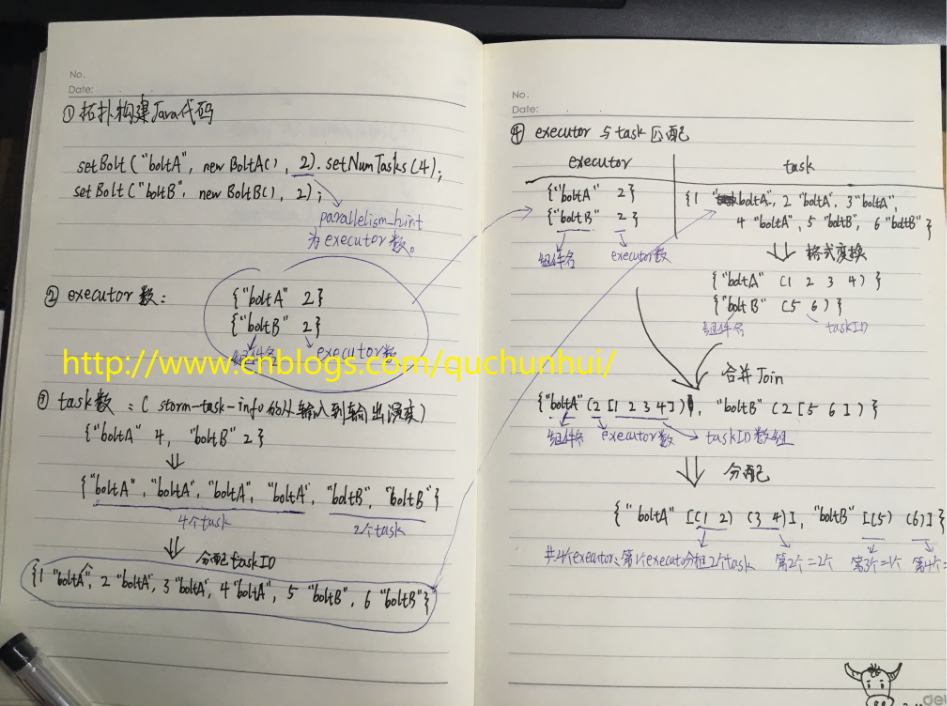==思考问题1==
向集群提交一个拓扑的时候,Storm是如何计算Task数以及Executor数的?
具体有多少个worker,多少个executor,每个executor负责多少个task?
==思考问题2:==
构建拓扑的时候,有3个地方会影响并行度,这3个地方之间有什么关系?
builder.setSpout("spout", new RandomSentenceSpout(), 5); //parallelism-hint
builder.setSpout("spout", new RandomSentenceSpout(), 5).setNumTask(1);
builder.setSpout("spout", new RandomSentenceSpout(), 5).setMaxTaskParallelism(1);
==3个参数的信息==
1、parallelism-hint:
构建拓扑时,可以通过setSpout或setBolt的函数参数中指定。为初始executor数。
如:builder.setSpout("spout", new RandomSentenceSpout(), 5);
2、 TOPOLOGY-TASKS:
构建拓扑时,通过Spout/Bolt的setNumTasks()方法来指定。为component的task数(Spout或Bolt)。
如:builder.setSpout("spout", new RandomSentenceSpout(), 5).setNumTask(1);
3、TOPOLOGY-MAX-TASK-PARALLELISM:
构建拓扑时,通过Spout/Bolt的setMaxTaskParallelism()方法来指定。为component的最大并行度。通常用于测试,在本地模式时使用。
如:builder.setSpout("spout", new RandomSentenceSpout(), 5).setMaxTaskParallelism(1);
==结论1:Executor数是多少?==
对应topology代码中, 为每个component指定的parallelism-hint数(通过setBolt和setSpout的参数)
==结论2:Task数是多少?==
版本号:apache-storm-1.0.1
代码路径:org/apache/storm/daemon/nimbus.clj
这里有一个函数非常重要,看了之后上面的3个关系多少会清晰很多。
该函数返回计算之后的真实的Task数。
(defn- component-parallelism [storm-conf component] (let [storm-conf (merge storm-conf (component-conf component)) num-tasks (or (storm-conf TOPOLOGY-TASKS) (num-start-executors component)) max-parallelism (storm-conf TOPOLOGY-MAX-TASK-PARALLELISM) ] (if max-parallelism (min max-parallelism num-tasks) num-tasks)))
这个代码是用clojure语言编写的,没有用过的人估计会非常蛋疼,
为了方便理解,用伪代码(方便理解)翻译之后,大概思路是这个样子的:
num-tasks = (TOPOLOGY-TASKS != null ? TOPOLOGY-TASKS : parallelism-hint); max-parallelism = TOPOLOGY-MAX-TASK-PARALLELISM; if (max-parallelism != null) { //取两者较小 return min(num-tasks, max-parallelism); } else { return num-tasks; }
如果将3个参数进行排列组合之后,获得结果如下:

简单理解来说:
1、暂时不考虑TOPOLOGY-MAX-TASK-PARALLELIS。(测试用的玩意儿,弄出来影响思路)
2、TOPOLOGY-TASKS优先于parallelism-hint。
==Executor与Task是如何匹配的?==
下面的代码是分配的代码
(defn- compute-executors [nimbus storm-id] (let [conf (:conf nimbus) blob-store (:blob-store nimbus) storm-base (.storm-base (:storm-cluster-state nimbus) storm-id nil) component->executors (:component->executors storm-base) storm-conf (read-storm-conf-as-nimbus storm-id blob-store) topology (read-storm-topology-as-nimbus storm-id blob-store) task->component (storm-task-info topology storm-conf)] (->> (storm-task-info topology storm-conf) reverse-map (map-val sort) (join-maps component->executors) (map-val (partial apply partition-fixed)) (mapcat second) (map to-executor-id) )))
理解这个代码之前,我们首先把注意力放在storm-task-info这个函数上,看看它都干了些什么。
代码位置:org/apache/storm/daemon/common.clj
(defn storm-task-info
"Returns map from task -> component id"
[^StormTopology user-topology storm-conf]
(->> (system-topology! storm-conf user-topology)
all-components
(map-val (comp #(get % TOPOLOGY-TASKS) component-conf))
(sort-by first)
(mapcat (fn [[c num-tasks]] (repeat num-tasks c)))
(map (fn [id comp] [id comp]) (iterate (comp int inc) (int 1)))
(into {})
))
来看看广大网友的解读版。参考博客:https://www.cnblogs.com/ierbar0604/p/4386480.html

这个函数, 首先读出所有components ,对每个component, 读出TOPOLOGY-TASKS(已经过标准化之后的TASK数,具体参照前面的内容),
最后用递增序列产生taskid, 并最终生成component和task的对应关系。
(如果不设置TOPOLOGY-TASKS,task数等于executor数,后面分配就很容易,否则就涉及task分配问题)
storm-task-info函数的输出,是这个样子的:
{1 "boltA", 2 "boltA", 3 "boltA", 4 "boltA", 5 "boltB", 6 "boltB"}
然后,我们把注意力返回到compute-executors函数(调用storm-task-info函数的调用处)。
还是用上面博客中,网友解读的版本来帮助我们理解。(注意:需要对照源码,确认当前版本代码是否有变化)

==我的笔记==

最后,从程序与StormUI界面对比来看看并行度的分配结果。
(拓扑程序)

(UI界面)

==简单总结==
1、有3个地方可以影响Task数,根据3个参数的结果决定Task数。
2、executor数 = 所有组件的parallelism-hint总数。
3、task数在生命周期内不变,executor数可能改变。
==rebalance命令==
storm运行过程中,而已使用rebalance命令动态调整拓扑的worker数及并发度。
命令模板:storm rebalance topology-name [-w wait-time-secs] [-n new-num-workers] [-e component=parallelism]* (*表示可以设置多个)
## 重新配置拓扑 "mytopology",使得该拓扑拥有 5 个 worker processes,
## 另外,配置名为 "blue-spout" 的 spout 使用 3 个 executor,
## 配置名为 "yellow-bolt" 的 bolt 使用 10 个 executor。
$ storm rebalance mytopology -n 5 -e blue-spout=3 -e yellow-bolt=1
-w:标记覆盖Storm在禁用与关闭期间等待的时间长度。
==其他疑问==
1、网上总是能看到,“不推荐使用setNumTasks”的方式来提高并发度。至于原因确实是一直没有搞明白。
答:如果只单纯的使用setNumTasks,不调整parallelism-hint,会造成多个Task运行在1个executor的结果。并不一定能够提高性能。
2、如果task数比executor数多,是否会有闲置executor?(需要用代码验证)
答:不会有闲置executor。
-------------
参考博客: